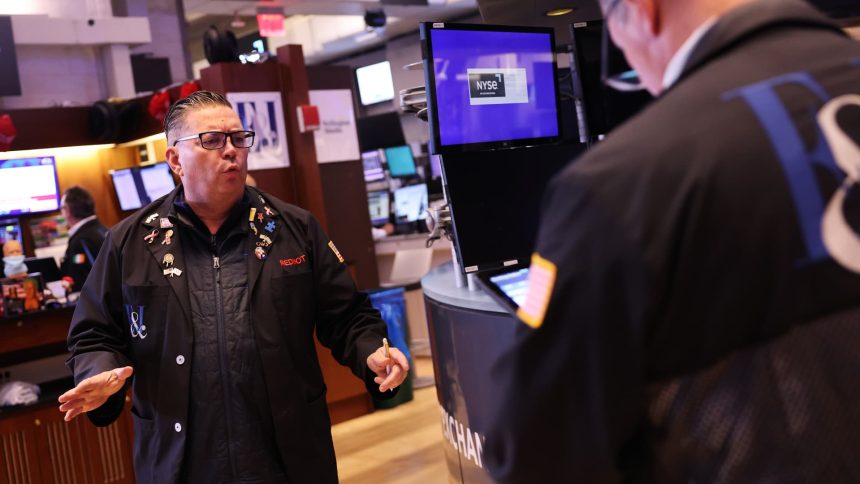With Labor Day come and gone and the summer lull on Wall Street over, the bears are getting louder just in time for the start of the worst month of the year for stocks. During Tuesday’s market rout, Jim Cramer said, “Buy the dip.” However, before buying in earnest for the Club, Cramer wants to see the overbought market, which has been that way since Aug. 19, abate. It’s going to take a lot more than a decline of 2.1% in the S & P 500 at the start of September trading to swing the Oscillator to oversold. At a higher-than-usual, 10% cash position after a series of discipline-mandated trims due to the overbought conditions, we’re prepared to buy and want to give members a behind-the-scenes look at our deliberations and five factors driving our discussions. Inflation : It’s coming down, slowly, but trending in the right direction. As a result, it is now clear that the Federal Reserve is about to start an interest rate-cutting cycle. The market is pricing in a 63% probability of a quarter-point cut later this month and a 37% likelihood of a half-point cut. The Fed is set to hold its next two-day policy meeting Sept. 17-18. We don’t expect the rate cuts to come nearly as fast as the hikes did, however, lower rates are certainly supportive of further economic growth — and, by extension, the stock market. Be it corporate funding or consumers spending a bit less to borrow money for large purchases like homes and cars, lower rates are fundamentally stimulative. That’s why you hear so many strategists and money managers, including Jim, say: “Don’t fight the Fed.” If businesses can more easily fund investments and consumers gain buying power, that all plays into corporate earnings. After all, the U.S. is a consumption-driven economy. We did not make the oil its own point because things can turn on a dime. But Tuesday’s more than 4.5% plunge in U.S. oil prices — should it continue — would also boost consumer buying power. Oil impacts the price of gas, which represents a large, unavoidable cost for pretty much all Americans. If you don’t own a car or pay a variable rate for heat, you’re still exposed. That’s because energy prices also represent a massive input cost for nearly all companies. So, any time you buy something, the price of oil is going to be factored into that end market price you see at the store. Election : The outcome of the 2024 presidential race probably won’t prove to be as big a deal as many commentators want to make it, at least in terms of the market. For starters, it’s foolish to think that one candidate is inherently better for the stock market. Think back to 2020, many pundits were saying that if Democrat Joe Biden won, the market would crater. Had you sold on Nov. 2, 2020, the day before the 2020 election, you would have missed out on the S & P 500’s roughly 70% advance under the current administration. The market starts to price in the new administration as of Election Day, not Inauguration Day. On the other hand, the market advanced about 55% from when Republican Donald Trump won the 2016 presidential election until when he left office. Biden wins in terms of nominal gains. But it’s going to be a lot closer with Trump maybe even ahead if you factor in inflation and consider returns on a real inflation-adjusted basis. In other words, what the market has actually done for buying power. That’s not a political statement but illustrative that deciding if the next few years in the market will be positive or not based on who sits in the Oval Office is not a great strategy. Instead, we need to think about the policies each will support and determine how those policies will impact various sectors. Democratic presidential nominee Kamala Harris and Trump have very different visions for the country. However, even then, keep in mind that it’s not just about the election, it’s also about Congress. Wall Street likes gridlock more than anything because gridlock means less uncertainty, and uncertainty is the worst thing for the markets because it means that not only is it harder to figure out which way things should be moving but to what magnitude the moves should be. So, currently, we don’t think the election is a reason to avoid the market. Rather, it’s a reason to keep focus on corporate fundamentals, which brings us to our third point. Earnings : The latest crop of quarterly results was largely better than expected. As Aug. 16, with most of S & P 500 companies reporting, FactSet calculated that nearly 80% beat expectations on earnings and 60% topped revenue estimates. From a bottom-up perspective, more companies are doing better than we thought than worse. From a top-down perspective, which focuses more on the economy, we already noted that inflation is coming down, so that’s a win. At the same time, unemployment remains low. We get the latest government employment report Friday. We just learned last week the U.S. economy in the second quarter grew a bit more than we previously thought. The manufacturing sector remains under pressure — but it’s private consumption that drives two-thirds of U.S. gross domestic product. In our view, investors need to take their cues from interest rates and employment, more so than manufacturing. And if you do that, you’re left realizing that the consumer remains resilient and buying power is increasing given that wage inflation is now tracking ahead of price inflation. Things could always be better. But it’s hard to bet on a sustained market downturn without a recession. We don’t see a recession. The economic data and the corporate earnings are not flashing recession. To be sure, we would be remiss not to address some key areas of risk. The two big ones, in our view, are geopolitical tensions and valuations. However, neither one is a reason to get out of the market. Geopolitics : We can’t make light of the tensions on the world stage. The Middle East is heating up. China is still talking tough on Taiwan. Russia and Ukraine are still at war. All the nations with a stake in those hotspots are surely watching which way the U.S. election goes as they plan their next moves. That said, does anyone remember a period in which you couldn’t list geopolitical tension as a key risk to the stock market? Again, not to make light of it, there is always the chance that as things heat up, or remain hot, that someone missteps or miscalculates and we end up in a much more volatile situation than we currently find ourselves in. However, if you focus too much on geopolitics, you’re never going to get involved in the market. Instead, acknowledge it as a risk, adjust accordingly as things change, and consider the impact potential outcomes may have on your investments. That’s what Jim means when he says every investor needs to have a worldview . Unless things get materially worse, which is far from our base case, it’s hard to say that investors should avoid the market altogether strictly because of geopolitics. Valuation : Price is what you pay. Value is what you get. Valuation is arguably the biggest issue for long-term investors to take issue with. Despite positive economic dynamics and corporate fundamentals, there is no doubt that a lot of that is already being priced in, with the S & P 500 now trading at about 21 times forward earnings. It’s not the highest price-to-earnings ratio we’ve seen in the past five years, but it’s up there. High valuations can be worked off in one of two ways: a decline in price or earnings growth. At the moment, the estimates, according to FactSet, are for S & P 500 earnings to come in at about $278 in 2025. That puts us at about 20 times 2025 numbers. Again, not cheap but improving due to expected earnings growth. Should we see the market pull back materially, with no change in fundamentals, then it only becomes cheaper. While it may not be prudent to aggressively buy the dip yet, we do think weakness from here justifies increased bullishness. That’s because we would be looking at more reasonable valuations based on earnings. That’s the valuation of the entire market. As investors in individual companies, we have the luxury of seeking out unique opportunities, where valuations might not be as extreme or where things may look undervalued. Advanced Micro Devices , for example, is a name we tossed around during Tuesday’s Morning Meeting, as a possible buy. AMD shares are trading at 31 times forward earnings estimates over the next four quarters. They are about 27 times 2025 earnings. Both are well below the 35 times forward multiple seen on average over the past five years. (Jim Cramer’s Charitable Trust is long AMD. See here for a full list of the stocks.) As a subscriber to the CNBC Investing Club with Jim Cramer, you will receive a trade alert before Jim makes a trade. Jim waits 45 minutes after sending a trade alert before buying or selling a stock in his charitable trust’s portfolio. If Jim has talked about a stock on CNBC TV, he waits 72 hours after issuing the trade alert before executing the trade. THE ABOVE INVESTING CLUB INFORMATION IS SUBJECT TO OUR TERMS AND CONDITIONS AND PRIVACY POLICY , TOGETHER WITH OUR DISCLAIMER . NO FIDUCIARY OBLIGATION OR DUTY EXISTS, OR IS CREATED, BY VIRTUE OF YOUR RECEIPT OF ANY INFORMATION PROVIDED IN CONNECTION WITH THE INVESTING CLUB. NO SPECIFIC OUTCOME OR PROFIT IS GUARANTEED.
With Labor Day come and gone and the summer lull on Wall Street over, the bears are getting louder just in time for the start of the worst month of the year for stocks.
Read the full article here
News Room




